Self-regulating heating cable: overview of types and features of use
Low winter temperatures can bring a lot of trouble if you do not take care of the insulation of drainage and sewer pipes, roofing elements and soil in the greenhouse in time. Frozen water turns into meter plugs from ice and destroys the hydrogen-water system, and ice on the roof is completely life-threatening.
A self-regulating heating cable laid through pipes, roofs and trays helps to change an unpleasant situation.
In this material we will tell in detail how to choose the right heating cable, describe its design features and the principle of operation. In addition, the article provides two options for installing self-regulating systems.
The content of the article:
Design differences of self-regulating systems
Samregs (in abbreviated form) should not be confused with resistive analogues - the first modifications of heating cables.
In short, the disadvantages of the resistive type, due to which it is used less and less, are as follows:
- a certain length, the inability to build up or shorten;
- constant resistance along the entire length, which makes it impossible to adjust the temperature in individual areas;
- connection from both ends, causing installation difficulties;
- risk of overheating at intersections;
- lack of repair as such, the whole system has to be changed.
A positive feature of the resistive type is its low cost, so it is used where small protected areas need heating.
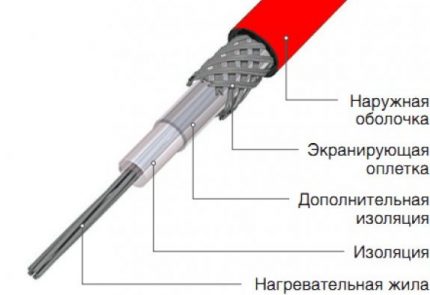
The design of the self-regulating heating cable has fundamental differences:
- Two copper conductors with a high degree of resistance. The greater the resistance, the higher the ability to adjust the temperature.
- Semiconductor matrix. This is a significant element of the cable, which makes it self-regulating. The matrix is sensitive to ambient temperature. As soon as the temperature drops, the resistance of the material rises and it begins to generate more heat.
- Internal insulation. Quality material is characterized by a uniform structure and maximum thermal conductivity.
- Shielding braid. Most often, it is a copper mesh or aluminum screen. To protect the cable, the power must be connected via an RCD.
- Outdoor insulation. Its function is to protect all cable elements. The life of the product depends on the characteristics of the external insulation.
The ability of a samreg to change its own resistance (and therefore power) from temperature fluctuations frees up the purchase of additional equipment - various thermostats with sensors.
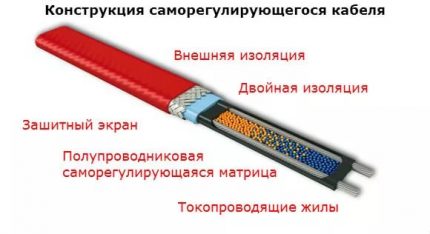
The cable can be cut, and the length of the finished product, if necessary, shorten or increase.
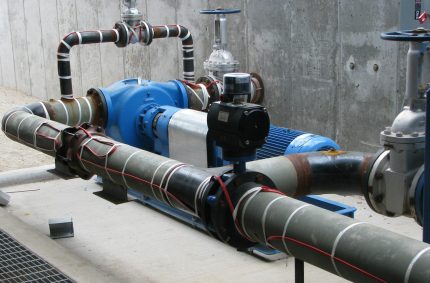
But the main advantage of the samreg is its “selectivity”. The matrix independently determines the cold areas and brings their temperature to the optimum value.
In sufficiently heated areas, it simply supports the necessary parameters (usually + 3-5 ºС). This is very convenient when it is necessary to protect the cable against freezing, throughout which has different heating conditions (for example, it passes through a heated room and through cold soil).
At the end of the cold season, there is no need to heat pipes, soil or roof, so the cable is disconnected from the power supply. When there is a possibility of severe night frosts, you can use the thermostat that automatically connects the system.
Where do they use heating systems?
The scope of heating cables for pipes (and not only) is quite large. They are mounted in places where adjustable heating of adjacent (surrounding) surfaces or materials is required.
Some types of cable are specifically designed for the equipment of "warm floor" systems. They are laid under ceramic tile, board, laminate, carpet, and sometimes poured with concrete screed.
The last option is the least effective, since the screed “steals” heat, and only part of it passes through the finish coating.
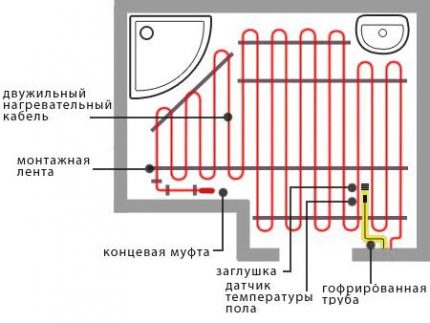
Cable heating is common in plumbing and sewage systems. Communications buried in the ground or passing above the ground in the northern regions of Russia are at risk of complete freezing for six months - from October to April.
If the pipeline is laid above the level of soil freezing and is not sufficiently insulated, it will quickly lose its performance. Therefore, we recommend that you learn more about the types of heating cable for water heating.
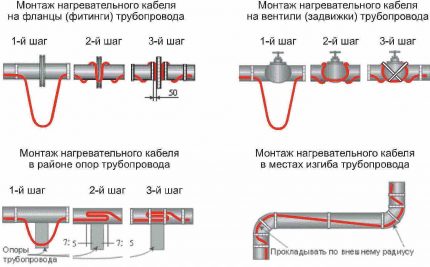
If the pipes are already buried in trenches and dismantling is impossible or undesirable, the cable is installed inside the water supply (sewer) pipe through a tee embedded in the most convenient place.
The next application of the self-regulating cable is roof heating systems and gutters.
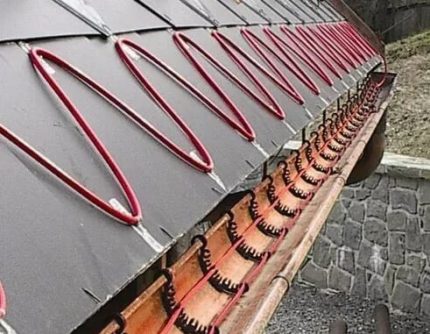
Under the influence of high temperature, snow and ice gradually turn into water, which flows down through trays and pipes. Roofs become safe for people and vehicles located in the yard.
The practical use of heating cables for those who do not like fogged glasses and mirrors is the fastening of the samreg on the back of the mirror, after which the condensate will no longer bother.
In production and during construction work, heating is often necessary as an aid to the "maturing" of concrete mortars.
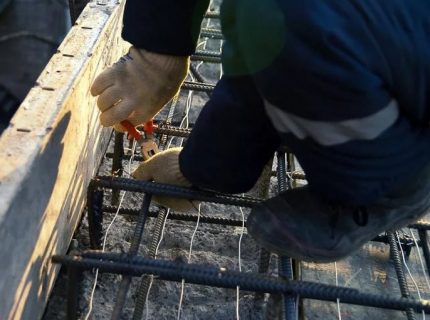
A similar situation is with liquids, to maintain a certain temperature which also use samregs. Instead of heating the tank with the process fluid in the traditional way, lower the cable into it, as a result, the characteristics of chemical or food solutions do not change for some time.
Heating systems did not bypass the agricultural industry. The cable is placed directly in the ground, under the upper nutrient layer, which protects the roots of crops from freezing.
What characteristics should I look for?
Before purchasing a cable, it is necessary to clarify the conditions in which it will be used. It is important to correctly calculate the power, set the length, take temperature readings, determine the installation method - internal or external.
Characteristics that will be required when choosing
Power. Power / resistance and heat transfer parameters are interconnected. Also, the properties of the cable depend on the cross section of the core. It should also be guided by it when choosing a length. Suppose a cable system with a cross section of 1.1 mm² and a power of 25 W should not be longer than 80 m.
The average power of samregs that can be found on sale is from 5 W / m to 25 W / m. Systems with a minimum value are suitable for internal heating of pipes laid in the ground. For the same pipes, but with external heating, the cable should be slightly more powerful - 10 W / m. The most severe conditions are above the ground, therefore, for overhead placement, the maximum power is suitable - from 25 W / m.
Temperature. It should be remembered that not all types of pipes tolerate heat equally well. Suppose plastic products (especially sewer and for cold water) are not designed for strong heating.
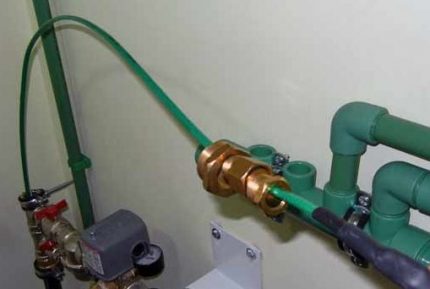
In production, there are cables that heat up to + 190 ºС (at a power of up to 90 W / m), however, in everyday life there is no use for them.
The presence of grounding braid. This security element is equally important for the system and for people - it guarantees the safety of installation. For the braid to function, it is connected through RCD. However, on sale you can find options without grounding - in some cases, their use is understandable.
External insulation material. Various types of polymers act as an external insulating material. Some of them are thinner and more elastic, others are bending stiff. All types, without exception, protect the internal parts of the cable from damage, aggressive environments, humidity.
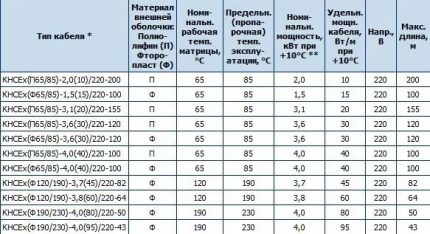
External insulation affects the use of the cable. Polyolefin protection (the most common material) is not suitable for all installation methods.
For example, for installation on a roof, a cable with insulation from fluoropolymers (with protection against UV rays) is used, and for indoor installation - systems with fluoroplastic insulation.
Self-adjusting cable installation instructions
There are many cable management options - the choice depends on the location and installation conditions. When arranging home autonomous communications, it is most often necessary to insulate the pipes, so we will dwell in more detail on the description of the processes of internal and external cable installation in the pipeline.
Option # 1 - Internal Installation
Installation of a heating cable inside a water or sewer pipe is carried out for various reasons. The main one is the impossibility of fixing due to the fact that the pipeline already lies in the trench and is closed by a layer of soil.
Of course, this type of installation has some disadvantages:
- the use of an additional part - a tee;
- reduction in cable properties due to plaque that appears after some time (depends on the characteristics of the water);
- reducing the diameter of the pipe, an additional obstacle to the movement of water;
- limited length and preferred use in straight sections.
An important point: Samreg is started only through a special tee, it is forbidden to use shut-off valves when connecting heating systems!
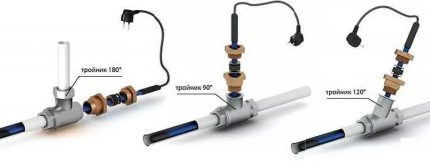
Instructions for use of the ready-made kit:
- connection to the cable of all functionally important details (terminal design, power cable connection);
- Tie-in with a free cable outlet;
- cable winding inside the pipe for a certain length;
- sealing the assembly with bushings or union nuts.
It is not recommended to insert samreg into a pipe with a cross section of less than 40 mm - this will affect the speed and volume of the fluid being transported.
How to prepare the cable and put on the end sleeve can be seen in the following instructions:
Now the cable is completely ready for installation inside the water supply system or sewer pipe.
Option # 2 - outdoor installation
It is not recommended to insert more than one cable inside a pipe, especially a narrow section, and from the outside you can place from 1 to 4 self-regulating cables. One is usually enough for a pipe of small diameter (40-50 mm), and from 2 to 4 pieces are used for large pipes located in low-temperature zones.
For communications placed in the ground, they often use the “golden mean” - two cables running in parallel along opposite sides.
For fixing use aluminum tape, designed to increase heat transfer and simultaneous protection. However, sometimes a stronger attachment is required - on the couplers. If direct rays of the sun fall on a pipe fragment, it is recommended to use black UV-resistant screeds.
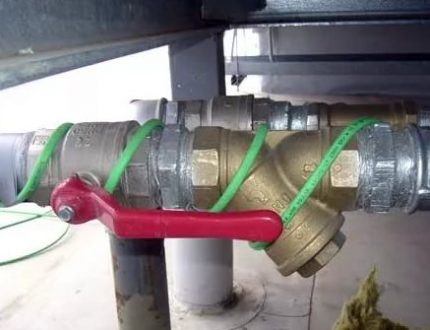
The spiral method covers the maximum surface area of the pipe.The smaller the step between the turns of the cable, the more efficient the heating. The average interval is 5-6 cm. The spiral is longer in length than a linearly laid cable, about 1.7-1.8 times. Mounting tape is used as fasteners.
Installation Instructions:
- The location of the cable along the entire length of the pipe section that requires heating, linear or spiral way.
- Winding during installation of connecting nodes, valves and other valves.
- Fixing with mounting tape (aluminum tape, screeds).
- Thermal insulation "in a sleeve".
The last item is mandatory. Thanks to the insulation, the heat generated by the cable is stored in the pipeline zone. The type and thickness of thermal insulation is chosen, focusing on the type of pipeline and environmental conditions.
Suppose, for laying a water pipe in a trench, in addition to a heating cable, insulation of 25-30 mm in thickness will be required - foam "shell", extruded polystyrene foam or basalt wool.
The nuances of roof heating
To create favorable conditions for the constant thawing of snow and ice on the roof and gutter system, the heating cable is mounted in the following places:
- on the edge of the roof (preferably around the perimeter);
- in the gutters under the ramps;
- in drainpipes;
- in the endows.
There are various options for installing a heating system: from a single cable stretched along the most critical place to a network of cables with a thermostat and sensors.
In open places, the cable is fixed with clamps and brackets, in pipes - suspended on a cable or chain.
Variant of the anti-ice system device:
The final stage is held indoors. We install an electric control cabinet and connect the heating system. Then we turn on the thermostat and check how the system works.
Conclusions and useful video on the topic
How to choose and mount a heating system, prompt the following videos.
How to fix samreg on a sewer pipe with a diameter of 110 mm:
Installation of the Deviflex cable system for heating gutters and roofs:
What does cable insulation look like in a concrete structure:
For the proper functioning of pipes or drains, samregs are often used, which create the most suitable temperature conditions. Installation requirements are reasonable if the cable is correctly selected.
Pay attention to the brands Raychem, Heat Trace, Nelson, Lavita and clearly follow the instructions that came with the cable. If you have any difficulties - contact the company representatives, they will certainly help you.
Please write comments in the block below. Perhaps you have practical skills in laying a self-regulating heating cable and you can give valuable advice to visitors to our site? Or there were questions about the topic of the article - ask them in the comments section, and we will try to respond to them promptly.

 Pipes for irrigation in the country: a comparative overview of various types of pipes
Pipes for irrigation in the country: a comparative overview of various types of pipes 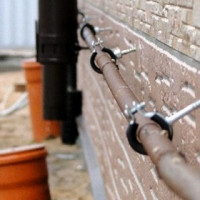 Pipe Clamps: Species Overview and Installation Instructions
Pipe Clamps: Species Overview and Installation Instructions 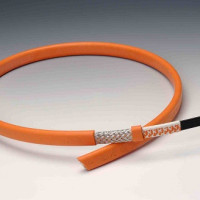 Heating cable for sewer pipes: types, how to choose and correctly carry out installation
Heating cable for sewer pipes: types, how to choose and correctly carry out installation 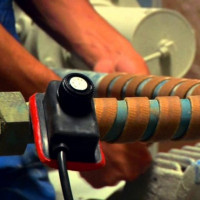 Heating cable for water supply: how to choose and correctly install it yourself
Heating cable for water supply: how to choose and correctly install it yourself 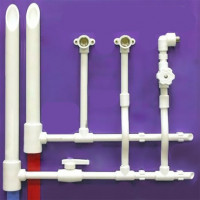 Installation of a water supply system from polypropylene pipes: typical wiring diagrams + installation features
Installation of a water supply system from polypropylene pipes: typical wiring diagrams + installation features 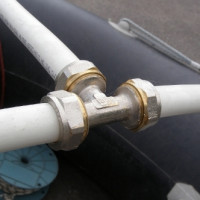 How to crash into a plastic pipe: features of work and analysis of all important nuances
How to crash into a plastic pipe: features of work and analysis of all important nuances  How much does it cost to connect gas to a private house: the price of organizing gas supply
How much does it cost to connect gas to a private house: the price of organizing gas supply  The best washing machines with dryer: model rating and customer tips
The best washing machines with dryer: model rating and customer tips  What is the color temperature of light and the nuances of choosing the temperature of the lamps to suit your needs
What is the color temperature of light and the nuances of choosing the temperature of the lamps to suit your needs  Replacement of a geyser in an apartment: replacement paperwork + basic norms and requirements
Replacement of a geyser in an apartment: replacement paperwork + basic norms and requirements
Winter is an unpredictable time of the year. It can be both warm and harsh. Last year, my parents took care of the installation of drainpipes in a timely manner. They laid a “heating” cable, and also insulated it with basalt cotton wool. Thanks to the measures taken in advance, the snow was melting; there were no gusts in these places, as happened to their neighbors. It works great!
Tell me, what are the properties of the outer Teflon insulation for the internal laying of the heating cable (devi dph-10)? Or is fluoroplastic required?
If you are directly interested in the self-regulating cable DEVIpipeheat 10 (DPH-10), then its external insulation is made of Teflon (fluropolimer). Ftoroplast is not used here, in this case you need to pick up another cable.
As for the Teflon insulation itself, then with an internal installation you can count on the following indicators:
- the maximum allowable water temperature is 40 * C;
- the maximum allowable water pressure is 10 bar;
- on the flat side, the minimum bending diameter is 2.5 cm;
- the strength of the cable itself corresponds to the classes M2 IEC 60800: 2009, IEC 60335-2-96.
And where does the information come from, that fluoroplastic is required for laying a heating cable inside the pipe?
In this model, a cold connecting wire with a euro plug, sealed heat-shrinkable adapter and end couplings are used.